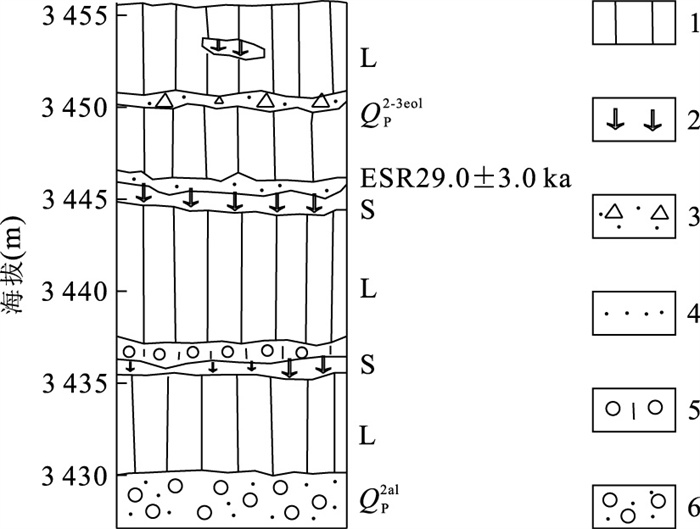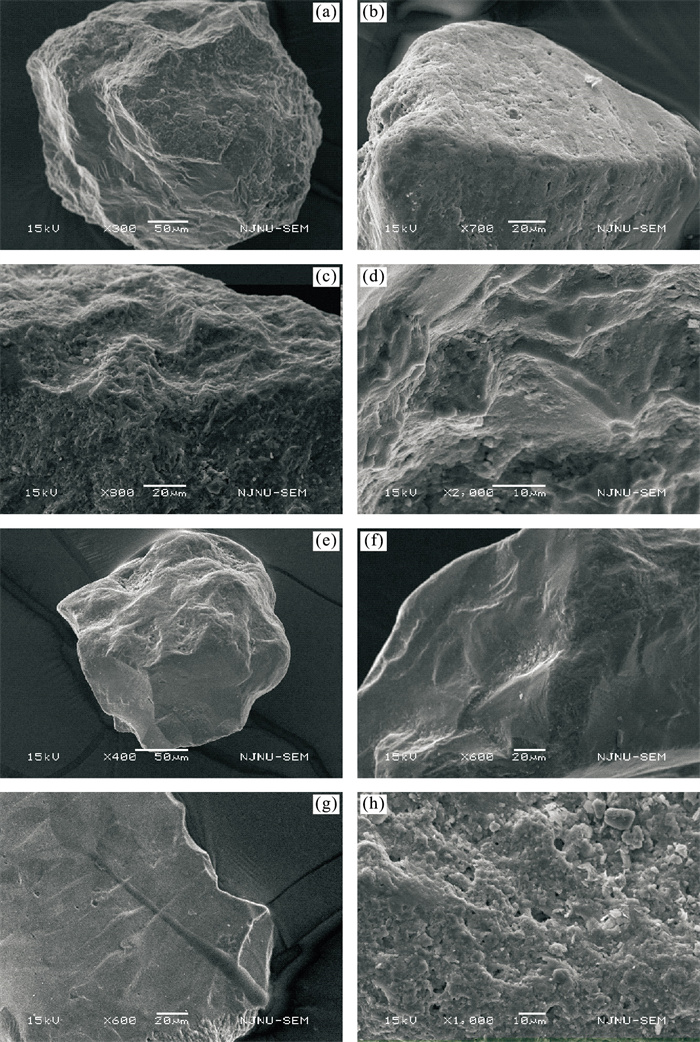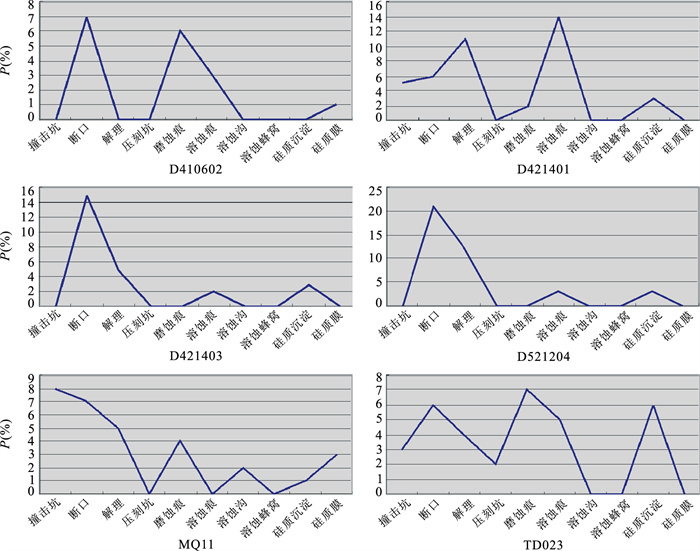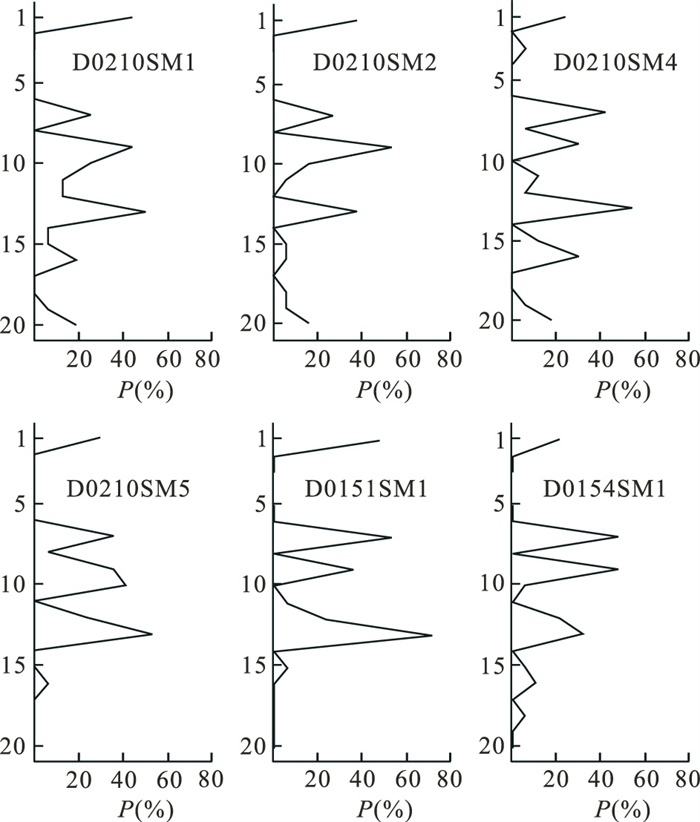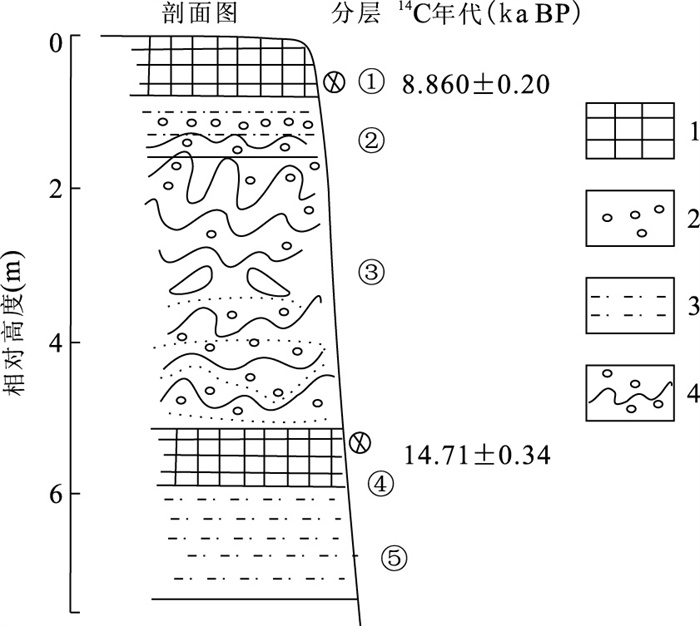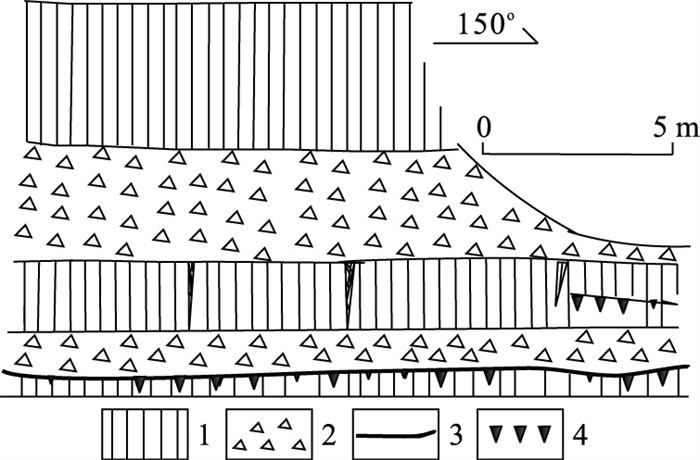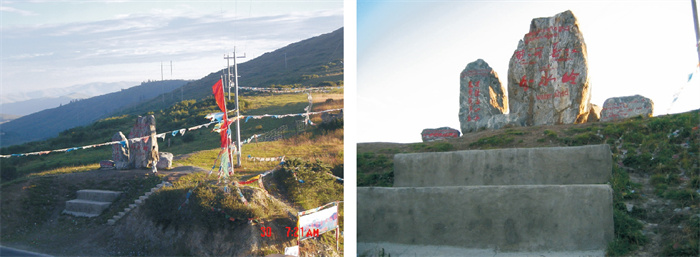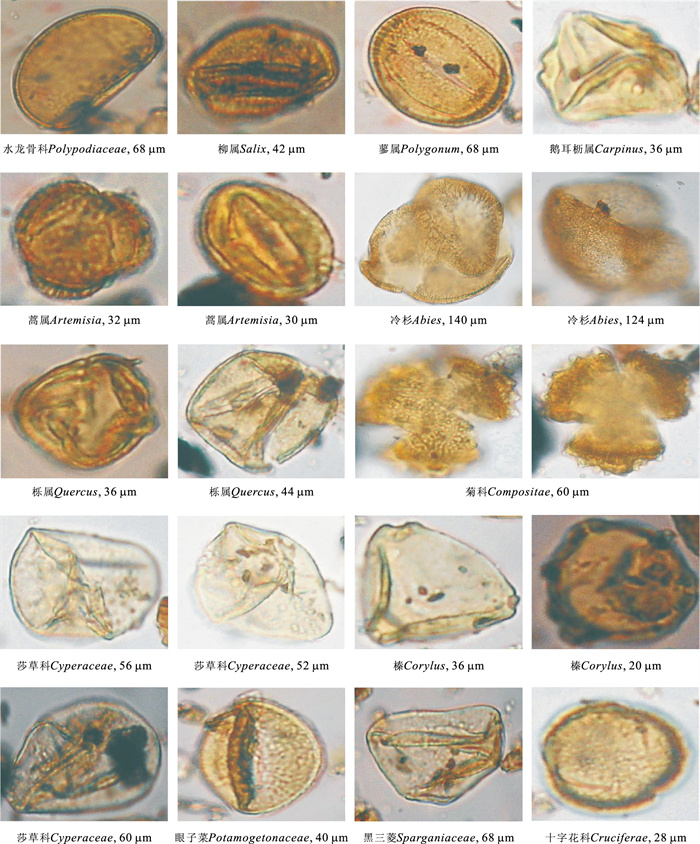Zoigê Basin Loess Origin in the Northeast Tibet Plateau
-
摘要: 通过对盆地黄土的粒度组分、石英砂的表面结构以及其它地质现象的综合研究,对若尔盖盆地黄土成因进行了探讨.在黄土的概率累计曲线上,跃进组分和悬移组分反映明显,以悬移组分为主,并采用矩阵法计算了黄土的粒度参数.对黄土扫描电镜观察和石英颗粒表面特征的统计分析,反映出气流搬运的特点,以发育碟形坑为其主要标志,具有风成环境的表面特征组合.黄土中孢粉稀少,并在邻区黄土层中发现有冰楔构造.根据上述特征分析出,若尔盖盆地黄土应为冰缘风成黄土.以测年资料为依据,黄土形成年代主要为马兰期茶镇梁子黄土和离石期索克藏寺黄土.Abstract: Loess origin of Zoigê basin has been discussed based on synthetic study in grain compositions of the loess, surface texture of quartz sand, as well as other geological phenomena. On the probability cumulative curve of loess, saltation mass and suspension are obvious, and the latter is dominant. Matrix method is adopted to compute grain size of the loess. The statistic analysis on quartz sand surface textures of loess through scanning electron microscope shows the features of air transportation, developed dishing pit, and combined profile features of Aeolian environment. In addition, sporo-pollens are scarce in the loess and ice-wedges are discovered in the neighboring loess strata. The above analysis shows that Zoigê basin loess is Aeolian sediment in the periglacial environment, the age of loess formation mainly are Chazhenliangzi loess of Malan period and Suokezang Temple loess of Lishi period.
-
Key words:
- Zoigê basin /
- loess /
- grain /
- quartz grain size /
- sporopollen /
- stratigraphy /
- Tibet plateau
-
表 1 若尔盖盆地黄土ESR测定结果
Table 1. Results of thermoluminescentt dating of loess in the Zoigê basin
实验号 野外号 采样地点 古剂量(Gy) 年剂量(mGy) 年龄(ka BP) M4 TK010 索克藏寺 766.7 5.99 128.0±13.0 M5 TK019 索克藏寺 142.3 4.92 29.0±3.0 M6 D421302 茶镇梁子 415.5 8.99 46.0±5.0 M7 D421203 茶镇梁子 151.6 6.19 24.0±2.0 P6 PM107ESR1 阿蒙沟 750.0 5.97 125.0±12.0 P5 PM107ESR2 阿蒙沟 227.2 6.24 36.0±4.0 P8 PM107ESR6 阿蒙沟 70.0 5.31 13.0±2.0 表 2 黄土的粒度参数
Table 2. Grain size parameters of loess
样号 层序 岩性 采样深度 粒度参数 (m) 中值粒φ 平均粒φ 分选系数r1 偏度SK1 峰态KG TK024 8 灰黄色黄土 6.5 6.18 7654 575 6.520 913 836 2.156 898 415 0.787 266 194 1.518 276 TK023 7 古土壤 7.2 7.374 314 299 7.765 047 595 3.758 331 873 0.514 585 242 0.720 281 TK022 6 红黄色黄土 8.4 6.922 089 823 6.029 317 419 2.884 532 742 0.719 693 176 1.507 022 TK021 5 古土壤 9.1 7.185 579 189 7.537 465 567 3.598 265 253 0.556 528 031 0.894 425 TK020 4 红黄色黄土 11.6 6.687 911 091 6.183 406 773 2.165 302 557 0.752 754 082 1.531 245 TK019 3 古土壤 12.0 8.255 597 758 8.271 893 572 3.864 909 498 0.518 950 612 1.072 959 TK018 2 红黄色黄土 13.3 6.828 649 679 6.014 104 475 2.160 512 037 0.763 613 909 1.503 031 TK017 1 古土壤 14.5 8.196 634 075 8.263 689 309 3.690 981 479 0.507 278 576 1.000 882 表 3 黄土的粒度参数对比
Table 3. Grain size parameters of loess
样号 岩性 粒度参数 中值粒径φ 平均粒径φ 分选系数r1 偏度SK1 峰态KG 若尔盖 黄土 6.625 6.221 2.465 0.687 1.518 古土壤 7.751 7.864 3.698 0.515 0.873 甘孜 黄土 6.341 6.613 3.024 0.623 1.312 古土壤 8.576 8.145 3.712 0.441 0.902 阿坝 黄土 6.543 6.673 2.753 0.712 1.243 古土壤 7.215 7.109 3.184 0.654 1.321 兰州 黄土 5.646 5.683 3.241 0.731 2.893 古土壤 6.652 6.864 2.923 0.542 1.143 洛川 黄土 6.325 6.043 2.984 古土壤 6.323 6.312 3.312 注:据王建民和潘保田(1997)资料补充. 表 4 黄土层中的孢粉鉴定
Table 4. Sporopollen appraising of loess
乔木Abors 草本Herbs 冷杉Abies 4粒D421405, 4粒D421406, 2粒D421407, 3粒D421408 禾本科Gramineae 2粒D421405, 2粒D421406, 2粒D421407, 1粒D421408, 2粒D421412 栎属Quercus 8粒D421405, 8粒D421406, 3粒D421407 蒿属Artemisia 2粒D421405, 2粒D421406, 5粒D421407, 6粒D421408, 5粒D421412 松属Pinus 3粒TK024, 2粒D421405, 2粒D421406, 10粒D421407 莎草科Cyperaceae 2粒TK024, 15粒D421405, 15粒D421406, 21粒D421407, 11粒D421408 榆属Ulmus 2粒D421405, 2粒D421406, 2粒D421407, 1粒D421408 菊科Compositae 3粒D421405, 3粒D421406, 5粒D421407, 2粒D421408 榛Corylus 5粒D421405, 5粒D421406, 1粒D421407, 4粒D421408 毛莨科Ranunculaceae 1粒TK024, 2粒D421405, 2粒D421406 桦木属Betula 1粒D421405, 1粒D421406, 1粒D421407 藜科Chenopodiaceae 3粒D421407, 1粒D421409, 1粒D421412 桤木属Alnus 2粒D421406, 1粒D421407 蓼科Polygonum 1粒TK024, 1粒D421406 胡桃Walnut 1粒D421405, 1粒D421406 蕨类Ferns 柳属Salix 4粒D421408 水龙骨科Polypodiaceae 3粒D421405, 3粒D421406, 1粒D421407 鹅耳枥属Carpinus 2粒D421407 卷柏Selaginellaceae 1粒D421408 桤木属Alnus 2粒D421405 紫萁属Osmunda 1粒D421408 杜鹃花属Rhododendron 1粒D421408 云杉Picea 1粒D421407 蔷薇科Rosa 1粒D421408 -
An, Z.S., Kukla, G.J., Poter, S.C., et al., 1991. Magnetic susceptibility evidence of monsoon variation on the Loess plateau of Central China during the last 130 000 years. Quaternary Research, 36(1): 29-36. doi: 10.1016/0033-5894(91)90015-W Chai, Z.X., 1982. Loess of the plateau in West Sichuan. In: Chinese Association for Quaternary Research, ed., Contribution to the Third National Quaternary Academic Meeting. Science Press, Beijing, 273-274 (in Chinese). Chen, F.B., Gao, S.H., Chen, J.L., et al., 1990. A preliminary study on Ganzi loess magnetostratigraphy. Chinese Science Bulletin, 35(20): 1600 (in Chinese). doi: 10.1360/csb1990-35-20-1600 Chen, S.Y., Fang, X.M., Wang, S.M., 2002. Relation between the loess stratigraphy on the eastern Tibetan plateau and Indian monsoon. Marine Geology & Quaternary Geology, 22(3): 41-46, 47 (in Chinese with English abstract). http://en.cnki.com.cn/Article_en/CJFDTOTAL-HYDZ200203007.htm Chen, S., Chen, G.J., Xu, G.L., 2008. Mechanism of geological deformation of the processes of formation and Huangtupo landslide. Earth Science—Journal of China University of Geosciences, 33(3): 411-415 (in Chinese with English abstract). doi: 10.3799/dqkx.2008.055 Deng, Q.L., Wang, X.P., 2000. Growth history of Huangtupo landslide: down-slope overlapping landsliding modification. Earth Science—Journal of China University of Geosciences, 25(1): 44-50 (in Chinese with English abstract). http://en.cnki.com.cn/Article_en/CJFDTOTAL-DQKX200001009.htm Fang, X.M., Li, J.J., Chen, F.B., et al., 1996. Garze loess and the evolution of the cryosphere on the Tibetan plateau. Chinese Science Bulletin, 41(20): 1865-1867 (in Chinese). doi: 10.1360/csb1996-41-20-1865 Gan, Z.M., 1989. Research Loess plateau surface and soil corrosion. The People Press of Shaanxi, Xi'an, 1-165 (in Chinese). Han, J.M., Hus, J.J., Liu, D.S., et al., 1994. Malan and Lishi Loess properties of magnetite. Quaternary Sciences, 4: 310-323 (in Chinese with English abstract). Heller, F., Liu, T.S., 1984. Magnetism of Chinese loess deposits. Geophysical Journal Internationa, 77(1): 125-141. doi: 10.1111/j.1365-246X.1984.tb01928.x Heller, F., Liu, D.S., 1986. Palaeoclimatic and sedimeotary history from magnetic susceptilility of loess in China. Geophys. Res. Lett., 13(11): 1169-1172. doi: 10.1029/GL013i011p01169 Heller, F., Shen, C.D., Beer, J., 1993. Quantitative estimates of pedogenic ferromagnetic mineral formation in Chinese loess and palaeo-climatic implications. Earth and Planetary Science Letters, 114(2-3): 385-390. doi: 10.1016/0012-821X(93)90038-B Jiang, F.C., Wu, X.H., Xiao, H.G., 1997. The Ganzi loess stratigraphy in the West Sichuan plateau. Acta Geoscientica Sinica, 18(4): 413-420 (in Chinese with English abstract). http://en.cnki.com.cn/Article_en/CJFDTOTAL-DQXB704.011.htm Krinsley, D.H., Doorcamp, J., 1973. Atlas of quartz sand surface textures. Cambridge Press, New York. Krinsley, D.H., Funnell, B.M., 1973. Environmental history of sand grains from the Pleistocene of Norfolk. The Quaterly Journal of the Geological Society of London, 121(484): 435-457. Kukla, G., 1987. Loess stratigraphy in Central China. Quaternary Science Review, 6(3-4): 191-207. doi: 10.1016/0277-3791(87)90004-7 Kukla, G., An, Z.S., Liu, D.S., 1990. Loess stratigraphy in Central China. In: Liu, T.S., ed., Loess, Quaternary geology and globe change (Part Ⅱ). Science Press, Beijing, 115-133 (in Chinese). Li, S.J., Shi, Y.F., Wang, S.M., 1990. Geology record of climate and environmental changes in ruoergai basin in the past 30 000 years. In: Tibetan Plateau Item Office, ed., Contribution to the formation evolution of Tibetan plateau and environmental changes and research of ecosystem. Science Press, Beijing, 227-235 (in Chinese). Liu, D.S., 1965. Chinese loess accumulation. Science Press, Beijing, 11-23 (in Chinese). Liu, D.S., 1985. Loess and environment. Science Press, Beijing, 191-208 (in Chinese). Lu, H.Y., An, Z.S., 1998. Paleoclimatic significance of grain size of loess-paleosol deposit in Chinese Loess Plateau. Science in China (Ser. D), 28(3): 278-283 (in Chinese). Lu, Y.C., Wen, Q.Z., Huang, B.J., et al., 1976. A preliminary discussion of the origin of loess materials in China. Geochimica, (1): 47-53 (in Chinese with English abstract). Maher, B.A., Taylor, R.M., 1988. Formation of ultrafine-grained magnetite in soils. Nature, 336: 368-370. doi: 10.1038/336368a0 Maher, B.A., Thompson, R., 1991. Mineral magnetic record of the Chinese loess and paleosols. Geology, 19(1): 3-6. doi: 10.1130/0091-7613(1991)019 Maher, B.A., 1999. Comments on "Origin of he magnetic susceptibility singal in Chinese loess". Quaternary Science Review, 18: 865-869. doi: 10.1016/S0277-3791(98)00108-5 Pan, B.T., Wang, J.M., 1999. Loess record of Qinghai-Xizang plateau monsoon variations in the eastern part of the plateau since the last interglacial. Quaternary Sciences, (4): 330-335 (in Chinese with English abstract). Pecsi, M., 1990. Loess is not just the accumulation of dust. Quaternary International, 7(8): 1-21. doi: 10.1016/1040-6182(90)90034-2 Qiao, Y.S., Guo, Z.T., Hao, Q.Z., 2006a. Grainsize features of a Miocene loess soil sequence at Qin'an: implications on its origin. Science in China (Ser. D), 49(7): 731-738. doi: 10.1007/s11430-006-0731-8 Qiao, Y.S., Zhao, Z.Z., Wang, Y., et al., 2006b. Magnetostratigrphy and its paleoclimatic significance of a loess soil sequence from Ganzi area, West Sichuan plateau. Quaternary Sciences, 26(2): 250-256 (in Chinese with English abstract). Sun, J.Z., Zhao, J.B., 1991. Loess plateau Quaternary. Science Press, Beijing, 12-34 (in Chinese). Tang, C.C., 2003. Formation and evolution of plateau the traditional and modern monsoon. In: Zheng, D., ed., Qinghai-Tibetan plateau formation on environment and development. Hebei Science and Technology Press, Shijiazhuang, 114-120 (in Chinese). Tian, D.Y., 1966. Loess survey of Ruoergai plateau in surrounding area. Geological Review, 24(1): 68-70 (in Chinese). Wang, F.B., 1992. Climate basic character during the Holocene. In: Shi, Y.F., ed., Chinese Holocene megathermal climate and environment. Marine Press, Beijing, 197-205 (in Chinese). Wang, J.M., Pan, B.T., 1997. Loess deposit in eastern part of Qinghai-Xizang plateau: its characteristics and environment. Journal of Desert Research, 17(4): 395-402 (in Chinese with English abstract). http://en.cnki.com.cn/Article_en/CJFDTOTAL-ZGSS704.009.htm Wang, S.B., Jiang, F.C., Tian, G.Q., et al., 2005. The Jinchuan loess stratigraphy in western Sichuan plateau. Acta Geoscientica Sinica, 26(4): 355-358 (in Chinese with English abstract). http://en.cnki.com.cn/Article_en/CJFDTOTAL-DQXB200504011.htm Wang, S.B., Jiang, F.C., Wu, X.H., et al., 1999. Paleomonsoon events from the last glacial maximum to Early Holocene in Sanmenxia area. Acta Geoscientica Sinica, 20(4): 433-438 (in Chinese with English abstract). Wang, S.B., Wu, X.H., Jiang, F.C., et al., 2000. Two loess profilesin Pinglu, Shanxi and corresponding paleoclimatic reconstruction. Journal of Geomechanics, 6(4): 27-36 (in Chinese with English abstract). http://en.cnki.com.cn/Article_en/CJFDTOTAL-DZLX200004004.htm Wang, Y.C., Cai, Z.X., Liu, S.Z., et al., 1999. The loess in Hengduan Mountains and its significance. Journal of Mountain Science, 17(4): 300-305 (in Chinese with English abstract). http://en.cnki.com.cn/Article_en/CJFDTOTAL-SDYA199904002.htm Wang, Y., Dinaruir, B., 1985. The atlas of surface texture of quartz grain size. Science Press, Beijing, 23-44 (in Chinese). Wang, Y.S., Li, Y.Z., Xiang, F., 2003. The Ganzi loess origin in the West Sichuan plateau. Journal of Geomechanics, 9(1): 91-96 (in Chinese with English abstract). http://en.cnki.com.cn/Article_en/CJFDTOTAL-DZLX200301012.htm Wu, X.H., Jiang, F.C., Xiao, H.G., et al., 1999. Mangshan loess on China Central plain and its response to tectonic movement and climate change during the last 200 ka. Science in China (Ser. D), 29(1): 75-81 (in Chinese). doi: 10.1007/BF02875240 Xie, Q.X., He, W.J., Qin, Y.L., et al., 2006. Regional geologic reconnaissance report of the PRC (1∶250 000). Sichuan Province Geology Investigate Bureau, Sichuan, 114-116 (in Chinese). Xu, S.Y., 1994. The paleosols and their reflection of the environmental changes in the northeast region of the Qinghai-Xizang plateau. Scientia Geographica Sinica, 14(3): 225-232 (in Chinese with English abstract). http://en.cnki.com.cn/Article_en/CJFDTOTAL-DLKX199403003.htm Zeng, F.M., Xiang, S.Y., Lu, Y.L., et al., 2007. Environmental evolution of Late Pleistocene loess deposits at Lintao County, Gansu Province. Earth Science—Journal of China University of Geosciences, 32(5): 703-712 (in Chinese with English abstract). http://en.cnki.com.cn/Article_en/CJFDTOTAL-DQKX200705015.htm Zhang, Z.H., Zhang, Z.Y., Wang, Y.S., 1989. Chinese loess. Geological Publishing House, Beijing, 16-32 (in Chinese). Zhu, Z.Y., 1994. Swarms of events and climatic-tectonic cycles with 0.4 Ma quasi-period. Geochimica, 23(1): 69-79 (in Chinese with English abstract). http://en.cnki.com.cn/Article_en/CJFDTOTAL-DQHX401.007.htm 柴宗新, 1982. 川西高原的黄土. 见: 中国第四纪研究委员会编, 第三届全国第四纪学术会议论文集. 北京: 科学出版社, 273-274. 陈富斌, 高生淮, 陈继良, 等, 1990. 甘孜黄土剖面磁性地层初步研究. 科学通报, 35(20): 1600. https://www.cnki.com.cn/Article/CJFDTOTAL-KXTB199020026.htm 陈诗越, 方小敏, 王苏民, 2002. 川西高原甘孜黄土与印度季风演化关系. 海洋地质与第四纪地质, 22(3): 41-46, 47. https://www.cnki.com.cn/Article/CJFDTOTAL-HYDZ200203007.htm 陈松, 陈国金, 徐光黎, 2008. 黄土坡滑坡形成与变形的地质过程机制. 地球科学——中国地质大学学报, 33(3): 411-415. https://www.cnki.com.cn/Article/CJFDTOTAL-DQKX200803018.htm 邓清禄, 王学平, 2000. 黄土坡滑坡的发育历史: 坠覆-滑坡-改造. 地球科学——中国地质大学学报, 25(1): 44-50. https://www.cnki.com.cn/Article/CJFDTOTAL-DQKX200001009.htm 方小敏, 李吉均, 陈富斌, 等, 1996. 甘孜高原黄土与青藏高原冰冻圈演化. 科学通报, 41(20): 1865-1867. doi: 10.3321/j.issn:0023-074X.1996.20.013 甘枝茂, 1989. 黄土高原地貌与土壤侵蚀研究. 西安: 陕西人民出版社, 1-165. 韩家懋, Hus, J.J., 刘东生, 等, 1994. 马兰黄土和离石黄土的磁学性质. 第四纪研究, 4: 310-323. https://www.cnki.com.cn/Article/CJFDTOTAL-DSJJ199104002.htm 蒋复初, 吴锡浩, 肖华国, 1997. 川西高原甘孜黄土地层学. 地球学报, 18(4): 413-420. https://www.cnki.com.cn/Article/CJFDTOTAL-DQXB704.011.htm 库克拉, 安芷生, 刘东生, 1990. 中国中部黄土地层学. 见: 刘东生编, 黄土·第四纪地质·全球变化(Ⅱ). 北京: 科学出版社, 115-133. 李世杰, 施雅风, 王苏民, 1990. 若尔盖盆地3万年来气候与环境变化的地质记录. 见: 青藏项目专家委员会编, 青藏高原形成演化、环境变迁与生态系统研究. 北京: 科学出版社, 227-235. 刘东生, 1965. 中国的黄土堆积. 北京: 科学出版社, 11-23. 刘东生, 1985. 黄土与环境. 北京: 科学出版社, 191-208. 鹿化煜, 安芷生, 1998. 黄土高原粒度组成的古气候意义. 中国科学(D辑), 28(3): 278-283. doi: 10.3321/j.issn:1006-9267.1998.03.002 卢演俦, 文启忠, 黄伯均, 等, 1976. 中国黄土物质来源的初步探讨——石英粉砂颗粒表面结构的电子显微镜研究. 地球化学, (1): 47-53. doi: 10.3321/j.issn:0379-1726.1976.01.006 潘保田, 王建民, 1999. 末次间冰期以来青藏高原东部季风演化的黄土沉积记录. 第四纪研究, (4): 330-335. doi: 10.3321/j.issn:1001-7410.1999.04.005 乔彦松, 赵志中, 王燕, 等, 2006b. 川西甘孜黄土磁性地层学研究及其古气候意义. 第四纪研究, 26(2): 250-256. https://www.cnki.com.cn/Article/CJFDTOTAL-DSJJ200602012.htm 孙建中, 赵景波, 1991. 黄土高原第四纪. 北京: 科学出版社, 12-34. 汤愁苍, 2003. 高原古今季风的形成与演化. 见: 郑度, 青藏高原形成环境与发展. 石家庄: 河北科技出版社, 114-120. 田代沂, 1966. 若尔盖高原边缘地区的黄土观察. 地质论评, 24(1): 68-70. doi: 10.3321/j.issn:0371-5736.1966.01.012 王富葆, 1992. 青藏高原全新世气候环境基本特征. 见: 施雅风主编, 中国全新世大暖期气候与环境. 北京: 海洋出版社, 197-205. 王建民, 潘保田, 1997. 青藏高原东部黄土沉积的基本特征及其环境. 中国沙漠, 17(4): 395-402. https://www.cnki.com.cn/Article/CJFDTOTAL-ZGSS704.009.htm 王书兵, 蒋复初, 田国强, 等, 2005. 四川金川黄土地层. 地球学报, 26(4): 355-358. doi: 10.3321/j.issn:1006-3021.2005.04.011 王书兵, 蒋复初, 吴锡浩, 等, 1999. 三门峡地区末次盛冰期至全新世早期的古季风事件. 地球学报, 20(4): 433-438. doi: 10.3321/j.issn:1006-3021.1999.04.015 王书兵, 吴锡浩, 蒋复初, 等, 2000. 山西平陆两个黄土剖面及古气候重建. 地质力学学报, 6(4): 27-36. doi: 10.3969/j.issn.1006-6616.2000.04.004 汪阳春, 柴宗新, 刘淑珍, 等, 1999. 横断山地区的黄土及意义. 山地学报, 17(4): 300-305. https://www.cnki.com.cn/Article/CJFDTOTAL-SDYA199904002.htm 王颖, Dinaruir, B., 1985. 石英砂表面结构图集. 北京: 科学出版社, 23-44. 王运生, 李永昭, 向芳, 2003. 川西高原甘孜黄土的成因. 地质力学学报, 9(1): 91-96. doi: 10.3969/j.issn.1006-6616.2003.01.012 吴锡浩, 蒋复初, 肖华国, 等, 1999. 中原邙山黄土及最近200 ka构造运动与气候变化. 中国科学(D辑), 29(1): 75-81. https://www.cnki.com.cn/Article/CJFDTOTAL-JDXK199901011.htm 谢启兴, 何文劲, 秦宇龙, 等, 2006. 四川省地质调查院. 四川: 中华人民共和国区域地质调查报告(1∶25万阿坝县幅), 114-116. 徐叔鹰, 1994. 青藏高原东北部的古土壤及其对环境变迁的反映. 地理科学, 14(3): 225-232. https://www.cnki.com.cn/Article/CJFDTOTAL-DLKX199403003.htm 曾方明, 向树元, 路玉林, 等, 2007. 甘肃临洮晚更新世黄土环境变迁. 地球科学——中国地质大学学报, 32(5): 703-712. https://www.cnki.com.cn/Article/CJFDTOTAL-DQKX200705015.htm 张宗祜, 张之一, 王云生, 1989. 中国黄土. 北京: 地质出版社, 16-32. 朱照宇, 1994. 具有0.4 Ma准周期的事件群发性与气候——构造旋回诌论——以黄土区为对比区. 地球化学, 23(1): 69-79. doi: 10.3321/j.issn:0379-1726.1994.01.008 -









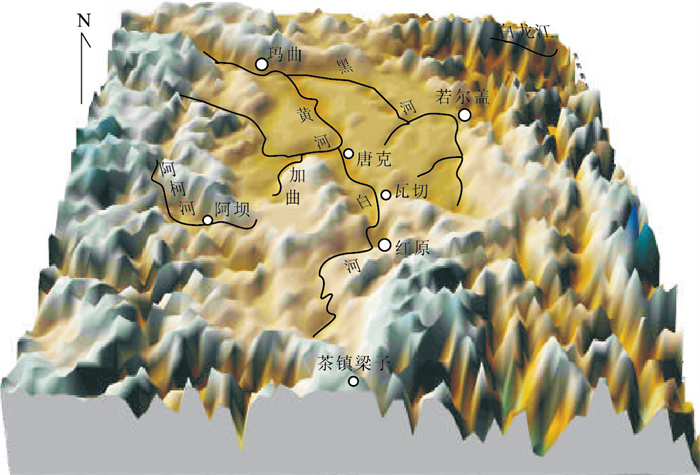
 下载:
下载:
